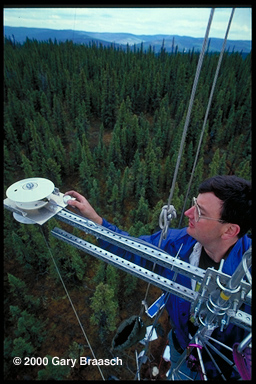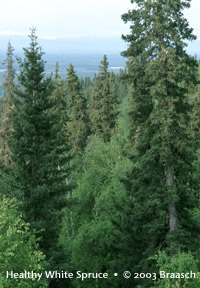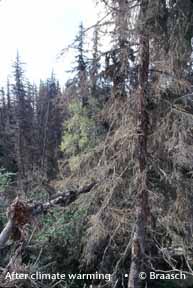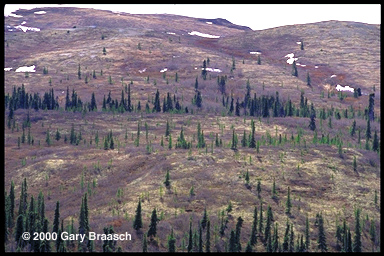Pushing the Boundaries of Life: Alaska

Meteorologist Scott Chambers of the University of Alaska
installs a radiometer on a 50-foot meteorological tower above a black
spruce forest near Fairbanks in May 1999. The boreal forest is the most
extensive and possibly least studied of the world's forests, and is thought
to be especially susceptible to climate change. Scientists suspect that
regional tree lines will move north, forests will dry and burn more often,
and insects will proliferate in a warmer climate.
Nearly 4 million acres of mature white spruce forest on the Kenai Peninsula have been killed by a growing population of spruce bark beetles (Dendroctonus rufipennis) since about 1987. This is a very active event, mediated by climate change, which has spread to about 38 million mature spruce. Scientists, including Dr. Edward Berg and Dr. Kenneth Raffa, attribute the beetle infestation to rising average temperatures in South-Central Alaska in both winter and summer. More beetle larvae can survive, and higher summer temperatures allow the insects to mature faster and complete a two-year life cyle in one year. The trees, which previously lived in balance with the beetles, do not have enough natural defenses against this assault.
 |
 |

New growth of black spruce on a hillside in Denali National Park headquarters, where botanist Glenn Juday has found that forest cover has advanced in elevation at the highest elevations over the last century. This is consistent with the hypothesis that forest area has increased during a 150-year warming trend. Average temperature at Denali park headquarters is 1.3° C warmer just since 1976. Other studies reported by the IPCC show that across the Arctic, boreal forests are expanding north at a rate equal to about 100 - 150 km per degree centigrade of average temperature increase.
Alaska's permafrost is also affected by climate change. See Glacier section, next.
"Sez who?": Reference 4
Each of the foregoing photos reports on documented science,
peer-reviewed published studies and scientific literature surveys. Those
references are listed later in this Web site, along with climate change
data, World View of Global Warming project advisors, and links to some
sources of climate information.
Photographs from the World View of Global Warming are available for license to publications needing science photography, environmental groups and agencies, and other uses. Stock photography and assignments available.
Use of photographs in any manner, in part or whole, without permission is prohibited by US copyright law. These photographs are registered with the US Copyright Office and are not in the Public Domain.
COPYRIGHT NOTICE:
Photography and text Copyright © 2005 - 2017 (and before) Gary Braasch All rights reserved. Use of photographs in any manner without permission is prohibited by US copyright law. Photography is available for license to publications and other uses. Please contact requestinformation@worldviewofglobalwarming.org. View more of Gary Braasch's photography here.


